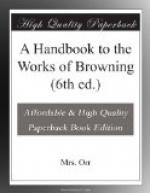The suggestion of her gipsy origin forms a connecting link between the real and the ideal aspects of the Duchess’s flight. We might imagine her fervid nature as being affected by the message of deliverance precisely in the manner described: while the beautified image of her deliverer transferred itself through some magnetic influence to the spectator’s mind from her own. He does not, however, present himself as a probable subject for such impressions. He is a jovial, matter-of-fact person, in spite of the vein of sentiment which runs through him; and the imaginative part of his narrative was more probably the result of a huntsman’s breakfast which had found its way into his brain. As in the case of Childe Roland, the poetic truth of the Duchess’s romance is incompatible with rational explanation, and independent of it. Various dramatic details complete the story.
SATIRICAL OR HUMOROUS POEMS.
Humour is a constant characteristic of Mr. Browning’s work,[90] and it sometimes takes the form of direct and intentional satire; but his sympathy with human beings and his hopeful view of their future destiny, are opposed to any development of the satirical mood. The impression of sympathy will even neutralize the satire, in poems in which the latter is directly and conciously conveyed: as, for instance, in “Caliban upon Setebos,” and “The Bishop orders his Tomb at Saint Praxed’s Church.” Of grim or serious satire, there is, I think, only one specimen among his works: the first part of
“Holy-Cross Day.”
("Dramatic Romances.” Published in “Men
and
Women,” 1855.)
We may class as playful satires (which I give in the order of their importance):
“Pacchiarotto, and how he worked in Distemper.” (1876.)
“Filippo Baldinucci
on the Privilege of Burial.”
("Pacchiarotto, and
other Poems.” 1876.)
“Up at a Villa—Down
in the City.” ("Dramatic Lyrics.”
Published in “Men
and Women.” 1855.)
“Another Way of
Love.” ("Dramatic Lyrics.” Published
in “Men
and Women.” 1855.)
We have a purely humorous picture in
“Garden Fancies,
II. Sibrandus Schafnaburgensis.” ("Dramatic
Lyrics.”
Published in “Dramatic Romances and Lyrics.”
1845.)
“HOLY-CROSS DAY” was the occasion of an “Annual Christian Sermon,” which the Jews in Rome were forced to attend; and the poem which bears this title is prefaced by an extract from an imaginary “Diary by a Bishop’s Secretary,” dated 1600; and expatiating on the merciful purpose, and regenerating effect of this sermon. What the assembled Jews may have really felt about it, Mr. Browning sets forth in the words of one of the congregation.




